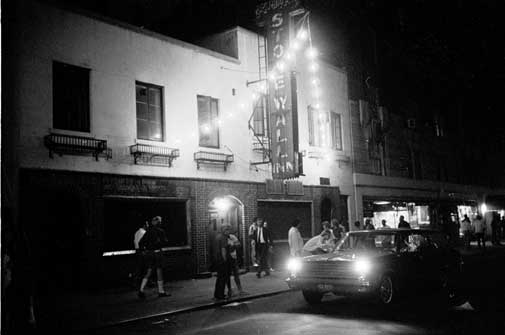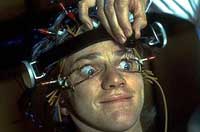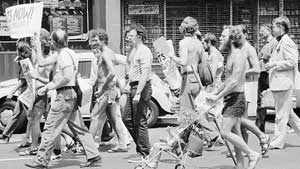
Monday's new PBS American Experience offering, Stonewall Uprising, is a 2010 documentary about the landmark clash between police and the patrons of a Greenwich Village gay bar in the summer of 1969 -- but filmmakers Kate Davis and David Heilbroner save that pivotal confrontation for last. The rest of their 90-minute study (9 p.m. ET; check local listings) is an often scary condensed summary of historical local and national attitudes regarding homosexuality...

Stonewall Uprising, shown in only a handful of theaters last year, deserves the wider audience that PBS will provide. Based on David Carter's book Stonewall: The Riots that Sparked the Gay Revolution, it starts by quoting veterans of the melee who provide helpful scene-setting metaphors. The Stonewall Inn, a Mafia-controlled gay bar in the Village, was the central meeting place, "the watering hole on the savannah." And when the patrons and their supporters stood up to police harassment, it was their "Rosa Parks moment."
Little footage exists from the initial clash at Stonewall, but this documentary provides plenty of TV and filmed images that set the stage. A CBS Reports documentary from 1967 quotes medical and psychological "experts" as saying that the idea of a "happy homosexual" is an oxymoron, and that homosexuality is "a mental illness."
In other films from the era, hidden-camera footage of young boys in play groups separate the "normal behavior" (a scary young kid swinging what I hope is a toy saw over another child's head) from behavior that the observers considered more deviant (one child meekly adjusts his tie).

And one illustrated form of "aversion therapy" used on some homosexual patients, to "cure" them, consisted of making them watch gay pornography while shocking them with electric current -- the real-life equivalent of, and precursor to, the Ludovico treatment in A Clockwork Orange.
"There was no 'out.' There was just 'in,'" recalls one person interviewed for Stonewall Uprising. One "former" homosexual appeared on TV to calm fears that gays were eager to marry one another, and to adopt children. "Homosexuals do not want that," he says flatly.
And then comes Stonewall, and a routine roust by the cops that, on one July night in 1969, was resisted by the Stonewall Inn customers. Pennies were thrown at the "coppers," battle lines were drawn -- and before long, the police found themselves barricaded inside the inn, with an ever-growing mob surrounding them outside.
Writing about it in the next issue of the Village Voice, the reporter referred to the unprecedentedly militant gay mob as "the forces of faggotry" -- and those forces descended immediately on the newspaper offices to protest that, too. That was the moment, recalls the reporter with a slight smile, the Voice's common description of homosexuals "switched from fag to gay."

From that came more nights of protests, an initially tense gay pride march up Sixth Street from the Village to Central Park, and the entire gay rights movement. "We were so innocent," says one proud, tearful participant of the initial protests. "And, oddly enough, we were so American."
Stonewall Uprising recaptures it well.